Chapter: Distributed and Cloud Computing: From Parallel Processing to the Internet of Things : Distributed System Models and Enabling Technologies
Software Environments for Distributed Systems and Clouds
SOFTWARE ENVIRONMENTS FOR
DISTRIBUTED SYSTEMS AND CLOUDS
This section introduces
popular software environments for using distributed and cloud computing
systems.
1. Service-Oriented Architecture (SOA)
In grids/web services, Java,
and CORBA, an entity is, respectively, a service, a Java object, and a CORBA
distributed object in a variety of languages. These architectures build on the
traditional seven Open Systems Interconnection (OSI) layers that provide the
base networking abstractions. On top of this we have a base software
environment, which would be .NET or Apache Axis for web services, the Java
Virtual Machine for Java, and a broker network for CORBA. On top of this base
environment one would build a higher level environment reflecting the special
features of the distributed computing environment. This starts with entity
interfaces and inter-entity communication, which rebuild the top four OSI
layers but at the entity and not the bit level. Figure 1.20 shows the layered
architecture for distributed entities used in web services and grid systems.
1.1
Layered Architecture for Web Services and Grids
The entity interfaces correspond to the Web Services Description Language (WSDL), Java method, and CORBA interface definition language (IDL) specifications in these example
distributed systems. These interfaces are linked with customized, high-level
communication systems: SOAP, RMI, and IIOP in the three examples. These
communication systems support features including particular message patterns
(such as Remote Procedure Call or RPC), fault recovery, and specialized
routing. Often, these commu-nication systems are built on message-oriented middleware
(enterprise bus) infrastructure such as Web-Sphere MQ or Java Message Service (JMS) which provide rich functionality and
support virtualization of routing, senders, and recipients.
In the case of fault tolerance, the features in
the Web Services Reliable Messaging (WSRM) framework mimic the OSI layer capability (as
in TCP fault tolerance) modified to match the differ-ent abstractions (such as
messages versus packets, virtualized addressing) at the entity levels.
Secur-ity is a critical capability that either uses or reimplements the
capabilities seen in concepts such as Internet
Protocol Security (IPsec)
and secure sockets in the OSI layers. Entity communication is supported by higher level services for registries, metadata, and
management of the entities discussed in Section 5.4.

Here, one might get several models with, for example, JNDI (Jini and Java Naming and Directory Interface) illustrating different approaches within the Java distributed object model. The CORBA Trading Service, UDDI (Universal Description, Discovery, and Integration), LDAP (Lightweight Directory
Access Protocol), and ebXML (Electronic Business using
eXtensible Markup Language) are
other examples of discovery and information services described in Section
5.4. Management services include service state and lifetime support; examples
include the CORBA Life Cycle and Persistent states, the different Enterprise
JavaBeans models, Jini’s lifetime model, and a suite of web services
specifications in Chapter 5. The above language or interface terms form a
collection of entity-level capabilities.
The latter can have performance advantages and
offers a “shared memory” model allowing more convenient exchange of
information. However, the distributed model has two critical advantages:
namely, higher performance (from multiple CPUs when communication is
unimportant) and a cleaner separation of software functions with clear software
reuse and maintenance advantages. The distributed model is expected to gain
popularity as the default approach to software systems. In the earlier years,
CORBA and Java approaches were used in distributed systems rather than today’s SOAP, XML, or REST (Representational
State Transfer).
1.2
Web Services and Tools
Loose coupling and support of
heterogeneous implementations make services more attractive than distributed
objects. Figure 1.20 corresponds to two choices of service architecture: web
services or REST systems (these are further discussed in Chapter 5). Both web
services and REST systems have very distinct approaches to building reliable
interoperable systems. In web services, one aims to fully specify all aspects
of the service and its environment. This specification is carried with
communicated messages using Simple Object Access Protocol (SOAP). The hosting
environment then becomes a universal distributed operating system with fully
distributed capability carried by SOAP messages. This approach has mixed
success as it has been hard to agree on key parts of the protocol and even
harder to efficiently implement the protocol by software such as Apache Axis.
In the
REST approach, one adopts simplicity as the universal principle and delegates
most of the difficult problems to application (implementation-specific)
software. In a web services language, REST has minimal information in the
header, and the message body (that is opaque to generic message processing)
carries all the needed information. REST architectures are clearly more appropriate
for rapid technology environments. However, the ideas in web services are
important and probably will be required in mature systems at a different level
in the stack (as part of the application). Note that REST can use XML schemas
but not those that are part of SOAP; “XML over HTTP” is a popular design choice in this regard.
Above the communication and management layers, we have the ability to compose
new entities or distributed programs by integrating several entities together.
In CORBA and Java, the distributed entities are
linked with RPCs, and the simplest way to build composite applications is to
view the entities as objects and use the traditional ways of linking them
together. For Java, this could be as simple as writing a Java program with
method calls replaced by Remote Method Invocation (RMI), while CORBA supports a
similar model with a syntax reflecting the C++ style of its entity (object)
interfaces. Allowing the term “grid” to refer to a single service or to represent a
collection of services, here sensors represent entities that output data (as
messages), and grids and clouds represent collections of services that have
multiple message-based inputs and outputs.
1.3
The Evolution of SOA
As shown in Figure 1.21, service-oriented architecture (SOA) has evolved over the years.
SOA applies to building grids, clouds, grids of clouds, clouds of grids, clouds
of clouds (also known as interclouds), and systems of systems in general. A
large number of sensors provide data-collection services, denoted in the figure
as SS (sensor service). A sensor can be a ZigBee
device, a Bluetooth device, a WiFi access point, a personal computer, a GPA, or
a wireless phone, among other things. Raw data is collected by sensor services.
All the SS devices interact with large or small computers, many forms of grids,
databases, the compute cloud, the storage cloud, the filter cloud, the
discovery cloud, and so on. Filter
services ( fs in the figure) are used to
eliminate unwanted raw data, in order to respond to specific requests from the
web, the grid, or web services.
A collection of filter
services forms a filter cloud. We will cover various clouds for compute,
storage, filter, and discovery in Chapters 4, 5, and 6, and various grids, P2P
networks, and the IoT in Chapters 7, 8, and 9. SOA aims to search for, or sort
out, the useful data from the massive
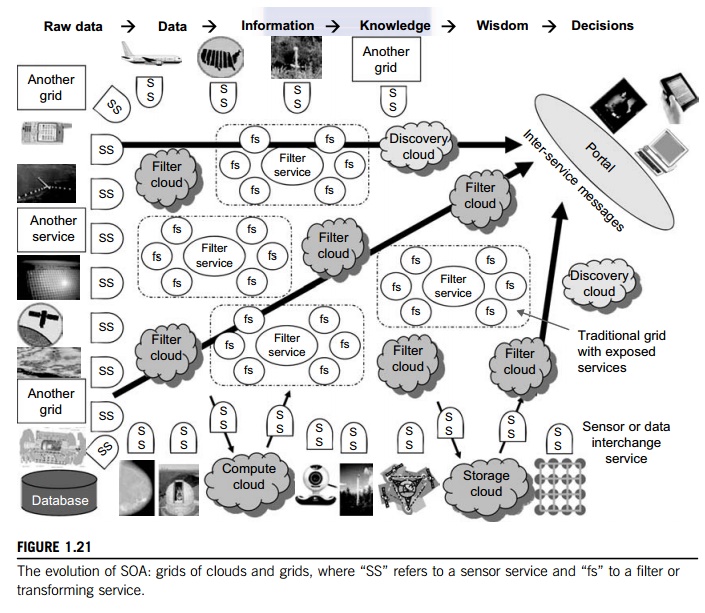
amounts of raw data items.
Processing this data will generate useful information, and subsequently, the
knowledge for our daily use. In fact, wisdom or intelligence is sorted out of
large knowledge bases. Finally, we make intelligent decisions based on both
biological and machine wisdom. Read-ers will see these structures more clearly
in subsequent chapters.
Most
distributed systems require a web interface or portal. For raw data collected
by a large number of sensors to be transformed into useful information or
knowledge, the data stream may go through a sequence of compute, storage,
filter, and discovery clouds. Finally, the inter-service messages converge at
the portal, which is accessed by all users. Two example portals, OGFCE and
HUBzero, are described in Section 5.3 using both web service (portlet) and Web
2.0 (gadget) tech-nologies. Many distributed programming models are also built
on top of these basic constructs.
1.4
Grids versus Clouds
The boundary between grids
and clouds are getting blurred in recent years. For web services, work-flow
technologies are used to coordinate or orchestrate services with certain
specifications used to define critical business process models such as
two-phase transactions. Section 5.2 discusses the general approach used in
workflow, the BPEL Web Service standard, and several important workflow
approaches including Pegasus, Taverna, Kepler, Trident, and Swift. In all
approaches, one is building a collection of services which together tackle all
or part of a distributed computing problem.
In
general, a grid system applies static resources, while a cloud emphasizes
elastic resources. For some researchers, the differences between grids and
clouds are limited only in dynamic resource allocation based on virtualization
and autonomic computing. One can build a grid out of multiple clouds. This type
of grid can do a better job than a pure cloud, because it can explicitly
support negotiated resource allocation. Thus one may end up building with a system of systems: such as a cloud of clouds, a grid of clouds, or a cloud of grids, or inter-clouds as a basic SOA architecture.
2. Trends toward Distributed Operating
Systems
The computers in most distributed
systems are loosely coupled. Thus, a distributed system inherently has multiple
system images. This is mainly due to the fact that all node machines run with
an independent operating system. To promote resource sharing and fast
communication among node machines, it is best to have a distributed OS that manages all resources coherently and
efficiently. Such a system is most likely to be a closed system, and it will
likely rely on message passing and RPCs for internode communications. It should
be pointed out that a distributed OS is crucial for upgrading the performance,
efficiency, and flexibility of distributed applications.
2.1
Distributed Operating Systems
Tanenbaum [26] identifies
three approaches for distributing resource management functions in a
distributed computer system. The first approach is to build a network OS over a large number of heterogeneous OS
platforms. Such an OS offers the lowest transparency to users, and is
essentially a distributed file system, with independent computers relying on
file sharing as a means of communication. The second approach is to develop
middleware to offer a limited degree of resource sharing, similar to the
MOSIX/OS developed for clustered systems (see Section 2.4.4). The third
approach is to develop a truly distributed
OS to
achieve higher use or system transparency. Table 1.6 compares the
functionalities of these three distributed operating systems.
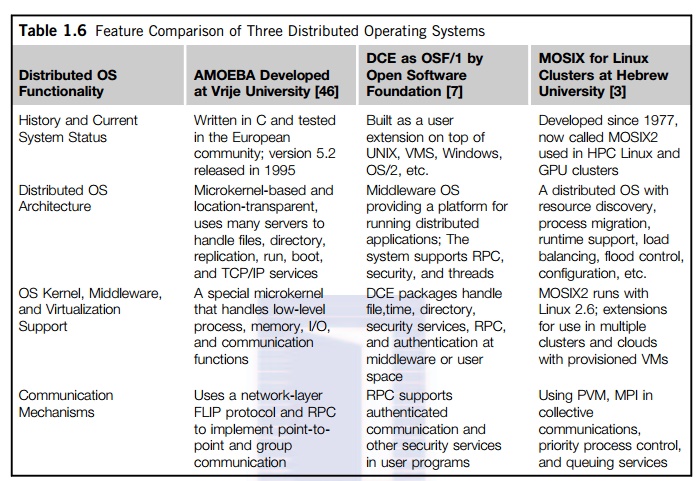
2.2
Amoeba versus DCE
DCE is a middleware-based
system for distributed computing environments. The Amoeba was academically
developed at Free University in the Netherlands. The Open Software Foundation
(OSF) has pushed the use of DCE for distributed computing. However, the Amoeba,
DCE, and MOSIX2 are still research prototypes that are primarily used in
academia. No successful commer-cial OS products followed these research
systems.
We need
new web-based operating systems to support virtualization of resources in
distributed environments. This is still a wide-open area of research. To
balance the resource management work-load, the functionalities of such a
distributed OS should be distributed to any available server. In this sense,
the conventional OS runs only on a centralized platform. With the distribution
of OS services, the distributed OS design should take a lightweight microkernel
approach like the Amoeba [46], or should extend an existing OS like the DCE [7]
by extending UNIX. The trend is to free users from most resource management
duties.
2.3
MOSIX2 for Linux Clusters
MOSIX2
is a distributed OS [3], which runs with a virtualization layer in the Linux
environment. This layer provides a partial single-system image to user
applications. MOSIX2 supports both sequential and parallel applications, and
discovers resources and migrates software processes among Linux nodes. MOSIX2
can manage a Linux cluster or a grid of multiple clusters. Flexible management of a grid allows owners of
clusters to share their computational resources among multiple cluster owners.
A MOSIX-enabled grid can extend indefinitely as long as trust exists among the
cluster owners. The MOSIX2 is being explored for managing resources in all
sorts of clusters, including Linux clusters, GPU clusters, grids, and even
clouds if VMs are used. We will study MOSIX and its applications in Section
2.4.4.
2.4
Transparency in Programming Environments
Figure 1.22 shows the concept
of a transparent computing infrastructure for future computing platforms. The
user data, applications, OS, and hardware are separated into four levels. Data
is owned by users, independent of the applications. The OS provides clear
interfaces, standard programming interfaces, or system calls to application
programmers. In future cloud infrastructure, the hardware will be separated by
standard interfaces from the OS. Thus, users will be able to choose from
different OSes on top of the hardware devices they prefer to use. To sepa-rate
user data from specific application programs, users can enable cloud
applications as SaaS. Thus, users can switch among different services. The data
will not be bound to specific applications.
3. Parallel and Distributed
Programming Models
In this section, we will
explore four programming models for distributed computing with expected
scalable performance and application flexibility. Table 1.7 summarizes three of
these models, along with some software tool sets developed in recent years. As
we will discuss, MPI is the most popular programming model for message-passing
systems. Google’s MapReduce and BigTable are
for
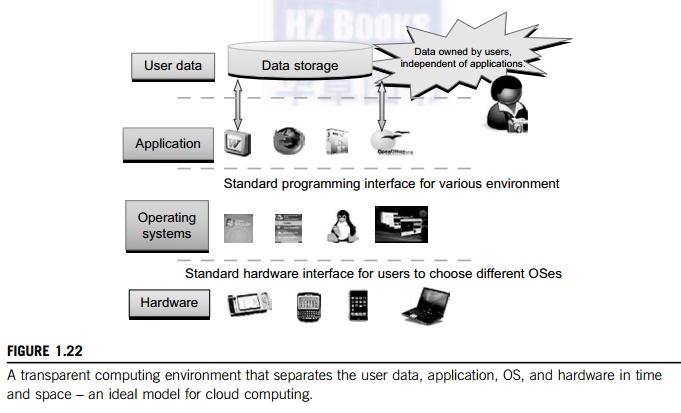
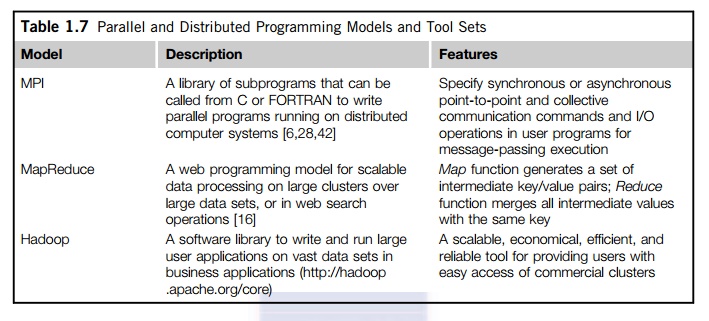
effective use of resources
from Internet clouds and data centers. Service clouds demand extending Hadoop,
EC2, and S3 to facilitate distributed computing over distributed storage
systems. Many other models have also been proposed or developed in the past. In
Chapters 5 and 6, we will discuss parallel and distributed programming in more
details.
3.1
Message-Passing Interface (MPI)
This is the primary
programming standard used to develop parallel and concurrent programs to run on
a distributed system. MPI is essentially a library of subprograms that can be
called from C or FORTRAN to write parallel programs running on a distributed
system. The idea is to embody clusters, grid systems, and P2P systems with
upgraded web services and utility computing applications. Besides MPI,
distributed programming can be also supported with low-level primitives such as
the Parallel Virtual Machine (PVM). Both MPI and PVM are
described in Hwang and Xu [28].
3.2
MapReduce
This is a web programming
model for scalable data processing on large clusters over large data sets [16].
The model is applied mainly in web-scale search and cloud computing
applications. The user specifies a Map function to generate a set of intermediate
key/value pairs. Then the user applies a Reduce function to merge all intermediate values with
the same intermediate key. MapReduce is highly scalable to explore high degrees of
parallelism at different job levels. A typical MapReduce computation process
can handle terabytes of data on tens of thousands or more client machines.
Hundreds of MapReduce programs can be executed simultaneously; in fact,
thousands of MapRe-duce jobs are executed on Google’s clusters every day.
3.3
Hadoop Library
Hadoop offers a software
platform that was originally developed by a Yahoo! group. The pack-age enables
users to write and run applications over vast amounts of distributed data.
Users can easily scale Hadoop to store and process petabytes of data in the web
space. Also, Hadoop is economical in that it comes with an open source version
of MapReduce that minimizes overhead
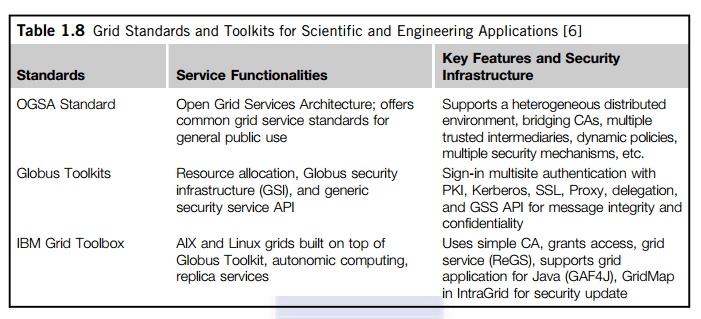
in task spawning and massive
data communication. It is efficient, as it processes data with a high degree of
parallelism across a large number of commodity nodes, and it is reliable in
that it auto-matically keeps multiple data copies to facilitate redeployment of
computing tasks upon unexpected system failures.
3.4
Open Grid Services Architecture (OGSA)
The development of grid
infrastructure is driven by large-scale distributed computing applications.
These applications must count on a high degree of resource and data sharing.
Table 1.8 introduces OGSA as a common standard for general public use of grid
services. Genesis II is a realization of OGSA. Key features include a
distributed execution environment, Public Key Infrastructure (PKI) services using a local certificate authority (CA), trust management, and
security policies in grid computing.
3.5
Globus Toolkits and Extensions
Globus is a middleware library jointly developed by
the U.S. Argonne National Laboratory and USC Information Science Institute over the past
decade. This library implements some of the OGSA standards for resource
discovery, allocation, and security enforcement in a grid environment. The
Globus packages support multisite mutual authentication with PKI certificates.
The current version of Globus, GT 4, has been in use since 2008. In addition, IBM
has extended Globus for business applications. We will cover Globus and other
grid computing middleware in more detail in Chapter 7.
Related Topics